| |
| Mining |
The ground always gets harder . . .
Mining is a wonderful place for an engineer who likes problems because the first rule of mining is to take the easy stuff first. This means that the difficulty always increases as the easy stuff runs out, so machinery that used to be adequate is no longer man enough for the job and has to be developed further for the new conditions. This is a continuous scenario of challenges for improvement.Underground . . .
I first got involved with mining as the assistant to Charlie Deamer, then Chief Engineer of Noyes Bros, in the design and development of shuttle cars for underground coal mining.One time, I remember, we had a prototype shuttle car on trial at Grose Valley pit, which had steering problems. It broke down right in the middle of a huge puddle of oily mud.
A fitter, Bob Janout, and I were there at the time, and
we got to work. I remember spending a good part of the time lying under
the machine in the oily mud. The pit was working on two shifts at the
time, knocking off at 11 pm. As we had not finished, we decided to keep
on after the crew had gone home. Our battery lamps had long run out but
there was adequate light from the other shuttle car.
Then at 2 am, when we had nearly finished, there was a black-out. Suddenly no light. There we were, standing in the middle of this puddle, rapidly becoming disorientated. To make matters more interesting, they were pulling pillars, which means that they were pulling back out of a mined area, mining out the support pillars as they went, and allowing the roof to collapse behind them. Things could become exciting if we walked the wrong way.
| So, holding hands, we walked away from the
creaking and
crashing of the roof coming in until we hit the rib, then sat down to
wait out the night. Total blackness, the intermittent noise of the face
caving, no fresh air as the surface fans
had gone off as well, trying to get some comfort out of cold wet lumps
of coal, in wet muddy oily overalls. Fortunately it was a gas free pit
so
there was no danger from this factor. We talked a bit but mostly dozed.
About 6:30 am, the day crew came in, not even knowing
that we were there. The power was still off, but as we had an urgent
need to see some day-light, we borrowed a safety lantern and started to
walk out up the conveyor line. A safety lantern is not really designed
to give light, more to give warning of gas, so we could hardly see at
all, particularly with the floor, walls and ceiling all being black. We could not follow the conveyor all the way as this would lead us to the coal bin, so we turned off at what I thought was the right cut-off, only to get lost. However, we figured that as long as we kept walking uphill we would have to get somewhere. We came across some old rail tracks, presumably from the loco haul system used before the conveyor was put in, so felt pretty confident that everything was under control. When suddenly, a long hairy face appeared before me in the faint light from the lantern. It was an old pit pony, the last one, living out its life underground, with a heap of hay in front and a pile of dung at back, not even tethered. Being at a slight loss for words, we said "g'day" politely and kept walking. Daylight was wonderful. I don't remember Bob the fitter ever going underground again after that night. The next version of the shuttle car became the Noyes Hydrocar which was a successful product for many years. This was a long time ago and, with much improved mine safety standards, it would be quite unacceptable for such a situation to occur today. |
 A Workshop Hoist for Underground Mine Locos and Vehicles  |
Good People . . .